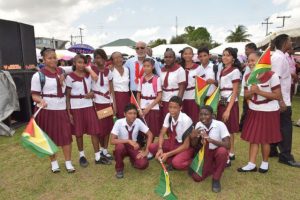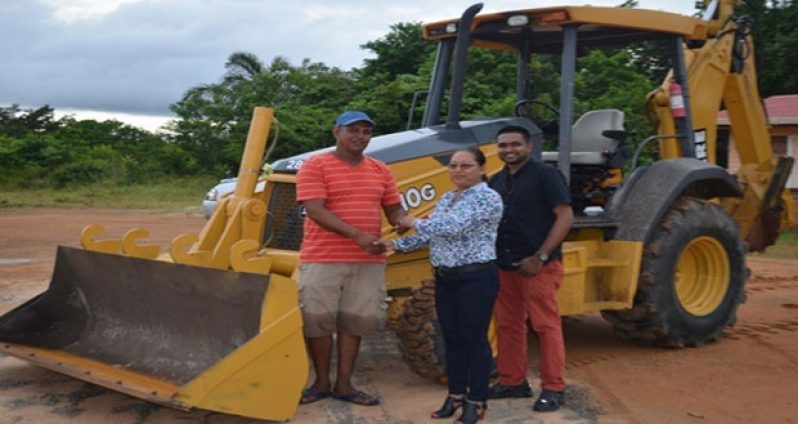THAT Amerindians have been a major part of the national socio-economic transformation since the PPP/C took office in 1992 is an understatement. In fact, the hinterland development programme series has been specifically tailored for the particular needs of hinterland development that will usher in self-sufficiency of hinterland communities, and bring Amerindians into the mainstream of national development.
Amerindian communities across the country are becoming financially independent as Government continues to implement policies and programmes that are transforming their village economies, and sustaining their traditional way of life and surroundings.

TRANSFORMING VILLAGE ECONOMIES
The Community Development Plans (CDPs), Presidential Grants and the Land Titling and Demarcation programme, are just a few of the initiatives that have allowed Amerindians to become self-sufficient.
Through the CDPs, under the Amerindian Development Fund and in accordance with the Low Carbon Development Strategy (LCDS), funding was provided to support the socio-economic development for approximately 180 Amerindian communities and villages through the implementation of income generating projects, including Village Infrastructure, Tourism, Manufacturing, Village Business Enterprise, Mining and Transportation.
During the first phase of this project, 26 hinterland communities and villages benefited from as much as $5Million each to start up a project that was chosen by the villages.
Santa Aratak Village, a riverine community in Region Three was the first to launch its project, the ‘Santac tours and Travel’. Moraikobai, Region Five completed rehabilitation works to their Multi-Purpose Centre, Kurukubaru undertook cattle rearing, and Rupertee village, cultivated five acres of cassava, and completed a processing facility.
Already, Guyana has received the second tranche of $ 1.3B for the implementation of the second phase of this project which will see 160 other communities benefitting.
Government continues to provide funds to the Ministry of Amerindian Affairs, through Presidential Grants which have significantly impacted Amerindian communities. This grant funds projects such as the construction of village shops, passenger cargo and fishing boats, the purchase of mini buses, tractors and All Terrain Vehicles (ATVs), among other ventures to improve life at the village level.
Taushida, Toka, Pai Pang, Rupanau, Rukumoto, Rewa Potarinau, Quarrie, Maruranau Quiko, Shulinab, Fly Hill, Yupukari are recent beneficiaries of this programme.

LAND TITLING
The implementation of the US$10.7M Land Titling and Demarcation project which provides absolute grants and certificates of title to Amerindian communities is moving apace.
During the first quarter of this year, Riverview/Falmouth and Batavia, Region Seven and Kariako, Region One were fully titled and received their certificates from the Amerindian Affairs Ministry. This programme began in 2013, targeting 45 villages and should be completed by the end of 2016.
EDUCATION OPPORTUNITIES
Apart from health, education can be considered the most important tool to sustain economic growth, and Amerindian communities have been provided with the necessary infrastructure which will enable them to receive the quality of education needed for their development.
Spread across the hinterland regions are over 250 schools, comprising 116 nursery, 139 primary, and 12 secondary schools, thus adequately catering for a wide spread of students.
The recently commissioned Paramakatoi Primary School, and the soon-to-be-completed state-of-the-art $780M secondary school at Kato, Region Eight will see a further boost in this sector. The Kato School is expected to house hundreds of students, and has an accompanying dormitory like all the other secondary schools in the hinterland.Additionally, the Hinterland Scholarship Programme continues to provide academic opportunities, both at the secondary and tertiary levels for approximately 80 hinterland students annually. It has thus far benefitted more than 1000 students.
Further, in order to further improve students’ attendance, Government embarked on the school uniform and school feeding programmes and more recently, an education grant programme. The latter, launched in 2014, provides each student, in the public school system, with $10,000 for transportation or other school related items.
Moreover, with the Information and Communication Technology (ICT) drive promoted across the country, through the One Laptop Per Family Programme, Amerindian communities are soon to benefit. Computer hubs are currently being installed in communities. Already secondary schools are equipped with computer laboratories, making research easier for students.
HEALTH
Government’s commitment to ensure Amerindians receive the much needed healthcare can be seen through the expansion of hospitals or health centres in every hinterland community.
To date, new medical hospital and centres have been built in Regions One, Seven, Eight, Nine and Ten. These are inclusive of the Regional Hospital at Lethem, Mabaruma, and Kumaka. Construction is ongoing at the Port Kaituma Hospital which will serve the Matarkai sub -district.
HOUSING
Hinterland communities are also benefiting from the national housing programme. Under the Second Low Income Settlement (LIS) Programme, $200M was set aside to provide 122 houses and to refurbish 86 roofs in eight communities in Regions One and Nine.
In Region One, the communities targeted were White Water, Manawarin and Oronoque, where 23 households benefited from new homes and 27 others had their roofs refurbished. In Region Nine, 23 households in Kwatamang benefited from roof refurbishment and 12 families received keys to their newly constructed homes, 12 in Katoka benefit from new houses and 10 had their roofs refurbished.
Additionally, Amerindians also benefited from a Hinterland Housing project. Thus far, 386 lots were distributed in Region Seven; 123 in Region Eight and 887 lots in Region Nine.
WATER
Billions of dollars have been expended towards the improvement of hinterland water supply through the Guyana Water Inc., (GWI) managed Hinterland Water Programme with accessibility of water accelerating from 25% to 80% over the past decade. The projected targets aim at 90% by 2016.
Implementation of the strategy has seen the installation of photovoltaic pumping systems, trestles and wells in Regions One, Five, Six, Nine and Ten.

ELECTRICITY
More than 80% of the hinterland communities have been provided with electricity, through the Hinterland Electrification Programme (HEP) project which was launched in 2004, with the implementation of grid systems at Mahdia, Port Kaituma, Lethem and more recently Matthews Ridge and Moruca.
Over 11,000 solar panels systems had also been distributed to in excess of 235 communities. Another 6,000 will soon be distributed that will benefit both the hinterland and coastal areas.
ROAD IMPROVEMENT
Because of the remoteness of most Amerindian communities, transportation to and from these locations is limited, and this explains why Government has initiated the hinterland road development project, so as to facilitate better connectivity. In 2014, the sum of $883M was expended to facilitate the establishment of new roads and maintenance of existing ones in the hinterland.
TRANSPORTATION ASSISTANCE
Communities continue to benefit from transportation assistance in the form of buses, tractors, ATVs and pickups to aid in community projects, transport students to school and emergencies, among other social purposes.
Among the recent beneficiaries are, Parabara, Achiwib, Potarinau and Rukumuto, Santa Rosa and Baramita, Karaudaranau, Sawariwau, Baitoon, Kattur, Shiriri, Quiko, Meriwau, Kakshibai, Quarrie, Apoteri, Taruka, Kamana, Kaibarupai, Kanapang Chiung Mouth, Paramakatoi, Semonie, El Paso, Micobie, Maikwak, Kanapang, Kako, Fairview, Kamwatta, Manawarin, Bethany, Kamwatta, Mabura, and Parikwaranau Rewa, Kabakuri, and Paramakatoi. (A GINA Feature)













